South by West- camping from Alaska to Nicaragua
9- Copper Canyon legends
Mary's hotel; Alexandro's mule; Satevo church; Cave dwellers; Expensive pencils; Silver mine ; Chicken bus; Safe return;
------------------------------------------------------------------
We stayed in Hotel Mary. The room, at $150 pesos a day, ~CD$23, was spartan, no TV, hot water in the outside shower would sometimes run, but we had electric sockets. Our neighbors had only bare wires sticking out of the wall and were charging batteries in our room. The staff were very nice, food in the restaurant good and cheap. Certainly we were not complaining and decided to stay three days.The inside courtyard had many plants whose dwarf versions were grown as house plants in Canada.
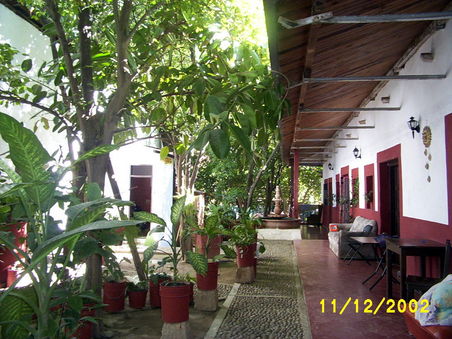
...house plants in Canada would turn green with envy if they saw their cousins in Mary's hotel...
As the priest promised, our guide Alexandro was waiting for us next morning with his mule. It was a rebuilt 1982 Ford pick up. He replaced the motor, exchanged automatic transmission with standard and in the back installed two bench seats so he could transport nine people. Springs felt soft but he assured me that brakes were in good condition and soon we were heading to Satevo, about 6 km away. The mule shook and rattled very badly but the loose bolts fell out a long time ago so there was nothing to worry about. The road was atrocious, full of washouts and holes, I would never dare to drive there. But Alexandro handled his mule like a Hummer.
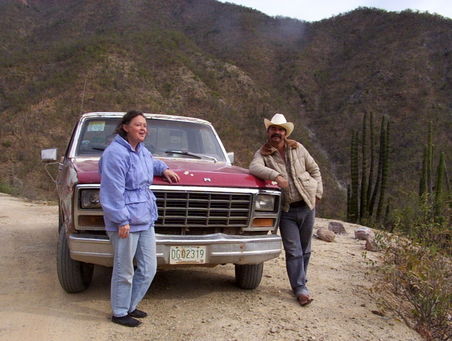
...Alexandro's mule...
The trip was worth it. The Satevo church was very old, built in the latter half of the 1500's, by Jesuits with the Indians providing the labor. The massive church built of bricks had seven domed cupolas and a three-tiered tower rising to a height of 80 feet. Alexandro borrowed a key and opened the solid door for us. Inside, the church was simple, with a small altar and benches, tiled floor and cupolas overhead. " When the cupola was finished a brick fell down and killed the architect. He is buried under the stones you are standing on", Alexandro told us.
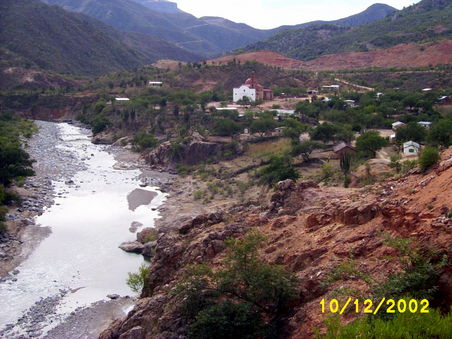
..."..a church deep in the canyon, completely forgotten..he risked his life.."...
I read in a travel magazine an article by a gringo, how he heard rumors about a church deep in the canyon, completely forgotten, without any history or records, standing in the middle of nowhere. How he risked his life to go into the canyon and rediscovered the church. This was all crap.
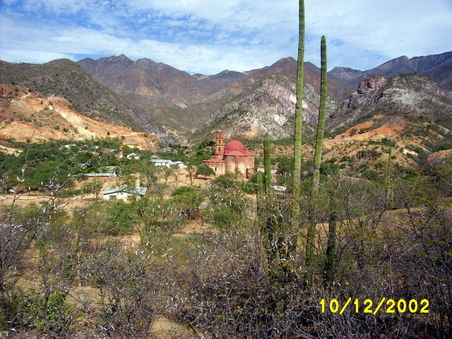
...Satevo gold is long gone but the church lives on in this Garden of Eden...
Alexandro, the priest and many others could have told him that a fire in the church a long time ago destroyed all records. The church was built in a town called Satevo that owed its existence to a rich gold mine. When the ore was exhausted people moved to nearby Batopilas. The town, built of adobe bricks, disappeared over the years, but the church built with fire bricks survived. Now the church is being restored, the outer walls needing bricks and plaster. Service is still held there, mostly for the Indians who also celebrate their traditional pagan rituals there.
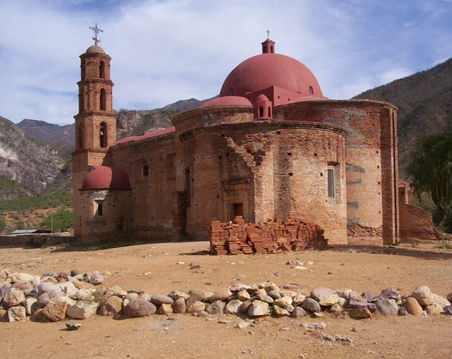
...and the four hundred years old church is now getting a brick lift...
Alexandro asked if we want to see Indians living in caves nearby. We climbed a hill and there were three caves with a girl maybe 13 standing outside. She was not dirty, rather covered with dust and carried a baby in her hands. "Her family is away, getting drunk", Alexander said scornfully. "Where is the mother?" I asked. "She is the mother" he said. I looked again and noticed that she was pregnant. She spoke only Tarahumara language. The entrance into the cave was barred with a crude fence of sticks and branches. We bought some simple clay pots from her and left.
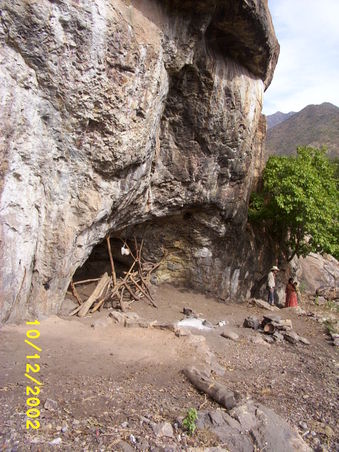
...Tarahumara Indians live in caves like their ancestors...
A little girl came to the hotel selling some cakes. She asked Sue for a pencil for school. Sue talked later to the priest and he said the church runs the school and a dormitory and needs everything. We decided to get some pencils. Nearby was a big booth selling tourist trinkets that had bag of pencils on a counter. So being do-gooders we went on a shopping mission. The kid selling the stuff was an insolent little bastard, sucking on a lollipop. He wanted 160 pesos for 40 pencils. We dickered, told him pencils were for the school and eventually paid 70 pesos for 20 pencils, forgetting to do the math. It seemed a bit too much and later I calculated we paid about 56 cents a pencil, an expensive town!! We stopped at a corner store to get fruit. They had pencils in a jar. "How much?" 1.5 pesos per pencil. I almost fainted, that little crook really took us to the cleaners!!
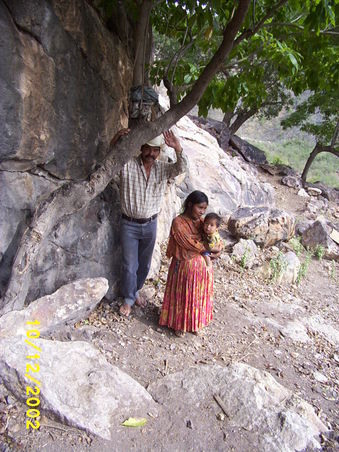
...she was left alone, with a baby, speaking only her native language...
It was too bad that we did not go to Barranca de Cobre before Alamos. I could have sent that RV caravan of retired US servicemen down to Batopilas to distribute their school supplies [See letter #5 Alamos]. It would be a one way trip for their rigs but the do-gooders would accomplish their mission in Mexico and would have felt good about it.
Next day Alexandro took us to more ruins across the river. There used to be a large complex of buildings, looking like a monastery. Actually it was a silver mine called San Miguel. In 1880 an American, Alexander Shepherd came to the town with his family to run the mine. He fell in love with the town and all profits from the mine were ploughed back into it. He built a silver smelter, foundry, and an aqueduct that still supplies town with water. Batopilas was the second city in Mexico to have electricity. "How would you transport 1" diameter steel cable 2000' long into town?" Alexandro asked me. I didn't have a clue. "Simple, unwind it, every 20 feet tie a mule to it and walk the cable down the Canyon". Wow, people were smart way back.
There were quite a few fancy pick ups driving around. I asked Alexander where people get money to buy such trucks. "Drugs" he replied. "don't go hiking alone in the canyon".
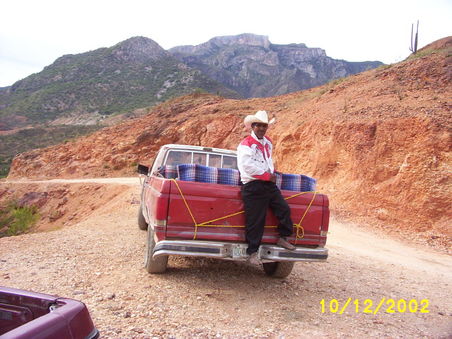
...This 80 years old Indian hitchhiker carried 40 lbs sack of corn to his home. It was a two day trip...
In the room without sockets was a couple from San Francisco that took the chicken bus from Creel to Batopilas. How was the ride? "Terrible, we were lucky to sit up front", she said. Somebody threw up in the back, baby had shitty diapers whole trip, no room to stretch legs and it was very bumpy. Well, what do you expect riding a old school bus down the mule trail? Berkley's travelers says: "The road has been called the best and the worst in North America. The scenery is magnificent, but the switchbacks are stomach wrenching".
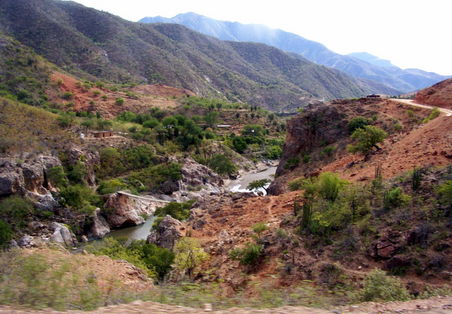
...people live in the other side of Batopilas river. They cross it on a rickety, swaying foot bridge...
We were going back to Creel just as Batopilas [and the whole Mexico] was celebrating the feast of The Lady of Guadeloupe, the patron of Mexico. There was going to be a parade, special church service and the Indians were holding their dance in Satove's church. But on that day, there would hardly be any traffic on the way up, bonus for us.
The road looked much friendlier on the way back [except for that worst section], we met overloaded 5 ton truck in a curve and passed each other without an incident. Bunch of cows decided to blockade the road but we negotiated a free passage. The 60 km trip to Samachique took one hour less to drive up, only four hours.
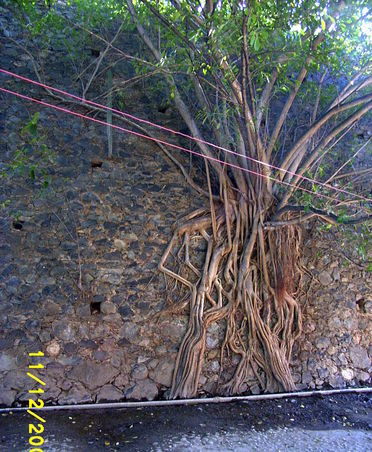
...anything will grow everywhere in Baranca de Cobre...
| Start of journey: | January 2003 |
| Duration: | 5 years |
| End of journey: | January 2008 |
Mexico
Guatemala
Belize
